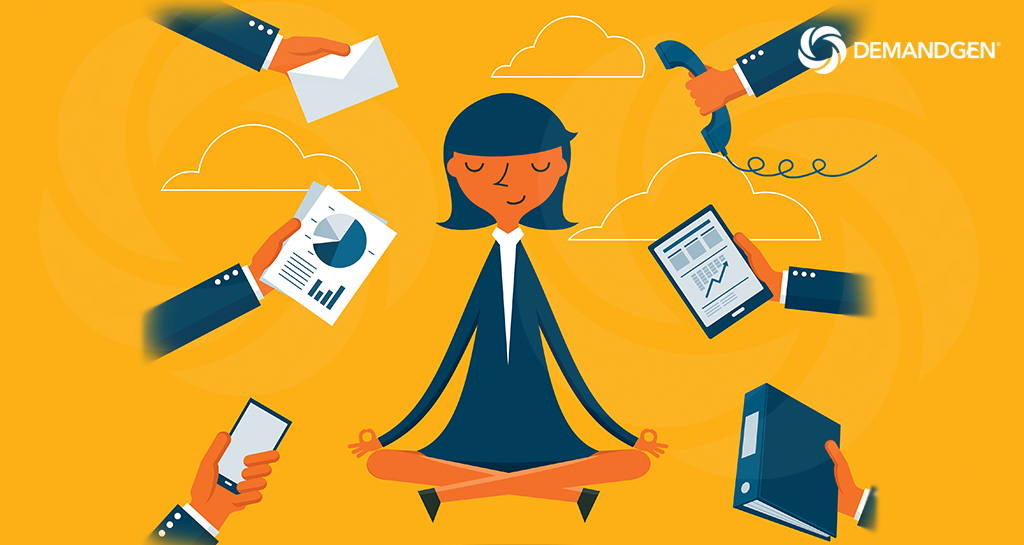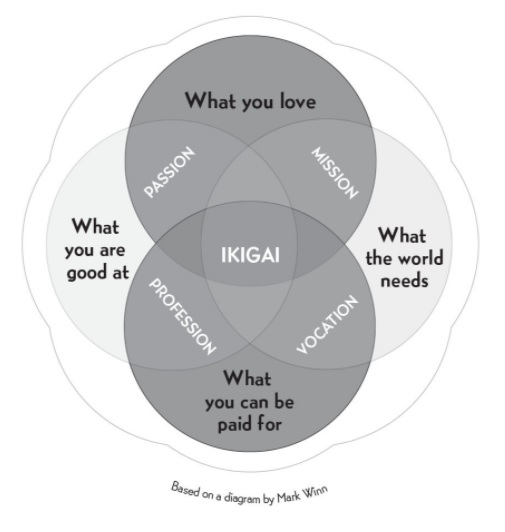
This past December, my stress levels were through the roof. I have a job that I love and am passionate about, so I wanted to understand why my day-to-day activities were wearing me down.
Fortunately, serendipity struck. While watching an instructional video (which I actually enjoy doing!), YouTube suggested I watch a video explaining the Japanese concept of ikigai, which loosely translates to “a reason for being.” Very timely. I was intrigued.
After watching the video, my initial take on ikigai was that’s it all about finding your purpose. Then, over the holiday, I read a wonderful book (and bestseller) called Ikigai: The Japanese Secret to a Long and Happy Life to learn more about the concept and how to apply it in my daily life.
As it turns out, ikigai is more of a philosophy or way of being. It’s not about finding your purpose, per se; it’s about being happy and content in your day to day (whatever that may entail), and doing that with purpose. As the book’s title suggests, it really is the secret to living a long and happy life.
And that’s not hyperbole. Ikigai hails from Okinawa, the oldest community in Japan, both in terms of the community’s founding and its citizens’ average lifespan. Their entire community, where living to 110 years old is commonplace, is centered around this principle, which Okinawans define as “the reason we get up in the morning.”
The focus of ikigai is the intersection of what you love (passion), what you are good at (profession), what the world (or customers, in this case) needs (mission), and what you can be paid for (vocation):

Source: Ikigai: The Japanese Secret to a Long and Happy Life
There are several basic tenets of this philosophy, but a big part of ikigai is getting to those moments during each day when you’re doing things with supreme focus and joy (you may know it as being in the zone or finding your flow).
So, in the hope that some of these techniques may be helpful for others, here are three time-tested techniques for structuring your time to help you find your flow.
- Be where you are and live in that moment.
This is the central tenet of ikigai and why meditation app downloads increased significantly last year. In order to be where you are and live in the moment, you must learn how to eliminate distractions. After all, how can you enter a state a flow — and actually stay there — amidst the constant dings of email, text, and chat notifications and back-to-back meetings?
It takes roughly 15 minutes of uninterrupted focus to reach a state of flow. After being interrupted, however, it can take more than 25 minutes to get back on track. While reading this book, I realized that an inordinate number of back-to-back calls each day had been playing a huge role in sending my stress levels sky high. When you have 10 back-to-back meetings in a single day, you can feel as if you’re already behind before your day even begins. And that can lead to multitasking during meetings.
However, research has found that when you multitask, your brain simply cannot process or retain information as well as when you focus on one task at a time. The book cites studies that found people actually reduce their productivity by 60 percent and decrease their IQ by more than 10 points while multitasking. That means you end up taking longer to do something — and you don’t even do it as well — than if you had focused on one task at a time.
I decided to give it a go. I turned off my Outlook notifications and internal chat platform notifications, and I silenced my phone. I committed to three set times a day when I’ll check and respond to email and phone calls. As a project manager, I do a lot of scheduling. I started scheduling 45-minute meetings instead of a full hour, allowing my teams 15 minutes to transition and refocus before joining their next meeting.
I’ll admit, it felt a little uncomfortable at first. I was so used to multitasking and jumping from one call to the next that I actually felt a little guilty, like I should have been doing more than what I was currently focusing on. That’s particularly problematic for people who work remotely. There’s this collective mindset that we need to be available at all times. When we’re eating dinner, our trusty phone lets us know a new email has just arrived in our inbox. We’re basically always plugged in now, which prevents us from both managing our time effectively and fully enjoying what we’re doing because we’re constantly interrupted.
So, how did not being so highly responsive (and conversely, less distracted) work out? Beautifully, actually. Whatever I’m focusing on gets my full attention. I’m not behind on any work, and I feel great about the respect I show others by being 100% present for them, in the moment. By scheduling time in my day to build flow, I’m better at my job, better at responding, and less stressed. There will always be exceptions when you have to schedule over it, but it shouldn’t be the norm.
- Increase your flow, but also challenge yourself within your skillset.
Once you identify what gets you into your flow, it’s important not only to increase that time, but also to challenge yourself within that skillset.
If you’re a programmer, learn to use a new programming language. If you’re a project manager, like myself, identify and learn a new project management skillset. Find ways to challenge yourself so that you don’t find yourself bored and stuck doing the exact same thing you’re doing now in 10-15 years.
Personally, I get a lot of joy from organization (yeah, I’m nerdy that way) and working within technology tools. Seriously, I can nerd out for hours. By building in uninterrupted time for me to do these things with supreme focus and joy, I can find my state of flow and improve my skillset at the same time.
Ultimately, by remembering why you chose your profession in the first place (such as a love of writing, love of programming, love of helping others) and by managing your daily activities in such a way that allows you time to do that work, you increase your happiness and contentment — and can even live longer!
- Use a compass instead of a map.
Recently, I wanted to get better at functional requirements gathering, a skillset within project management. I didn’t create a fixed roadmap to follow step by step. Instead, I asked myself why I wanted to get better at it (my objective) and what I ultimately wanted to achieve (my results).
Getting better at something isn’t an objective in and of itself. There is always a reason behind it. Say you want to learn how to play the guitar. You’re don’t purchase a guitar and take lessons just so you can play the guitar. You do so because you love music. It makes you happy. Or, maybe you want to learn how to use complex formulas in Microsoft Excel so you can more easily identify trends and visually share the results with your team.
Personally, my objective was to help reduce pain points on my projects, and I wanted to get more proficient at capturing requirements as a result. Digging deeper to uncover my “reason for being” for honing my skills, instead of merely creating a linear to do list, served as a compass to help guide me toward my goal. The good news is that the purely tactical steps of turning off notifications and setting specific times to check my email has given me the freedom to focus on something that brings me joy and pushes forward my own skillset at the same time.
When you work on something, always determine what your objective is and the results you want to achieve. Then, even if you run into some roadblocks, you’ll be able to continue navigating toward your goal using your inner compass instead of giving up because you couldn’t complete task #7 on your to do list.
Move over, kintsugi
Learning about ikigai was a game changer for me in terms of discovering how to manage my own happiness every day and doing things I love to do — while also being responsible for the things I need to do. And, when you enjoy the work you’re doing, your passion manifests into a better client experience.
It’s normal to want to find meaning and purpose in what we do for a living. We all got into whatever we’re doing professionally because the subject matter interested us. Constant interruptions and quickly shifting business needs, however, often prevent us from getting lost in our work. While we can’t always control external stressors, we can create some structure in our days to help us get lost in the work that brought us here in the first place.
I may have happened upon the concept of ikigai by chance, but I’m now very intentional about implementing it in my everyday life. Kintsugi, the art of filling in the cracks to create something even more beautiful, is what everyone needed in 2020. Ikigai is what we should all be striving for in 2021.
 Jennifer McKinney is a certified Project Management Professional (PMP) with experience guiding projects within the government, private, and nonprofit sectors. She enjoys ongoing education and skill advancement, and helping teams find operational efficiencies that result in higher productivity and job satisfaction.
Jennifer McKinney is a certified Project Management Professional (PMP) with experience guiding projects within the government, private, and nonprofit sectors. She enjoys ongoing education and skill advancement, and helping teams find operational efficiencies that result in higher productivity and job satisfaction.
The post 3 Techniques to Help You Find Your Flow Every Day Using the Japanese Concept of Ikigai appeared first on DemandGen.



![The Importance of Marketing Technology in 2021 — and How to Ensure Your Stack Is Up to the Challenge [Guide]](https://content.cdntwrk.com/mediaproxy?url=https%3A%2F%2Fwww.demandgen.com%2Fwp-content%2Fuploads%2F2021%2F01%2Fmartech-2021_1_demandgen.jpg&size=1&version=1712702759&sig=bebc2787257205b9adb9eab757b541ba&default=hubs%2Ftilebg-blogs.jpg)



















